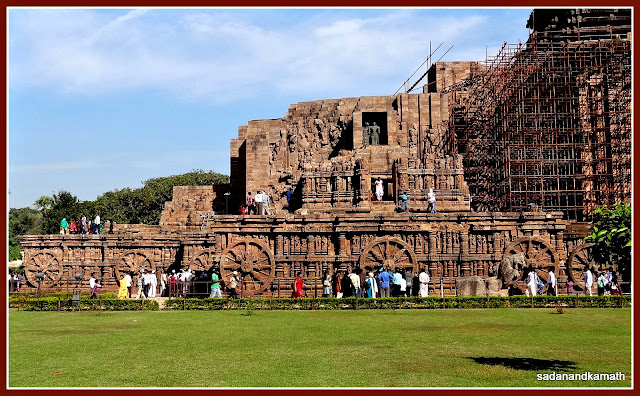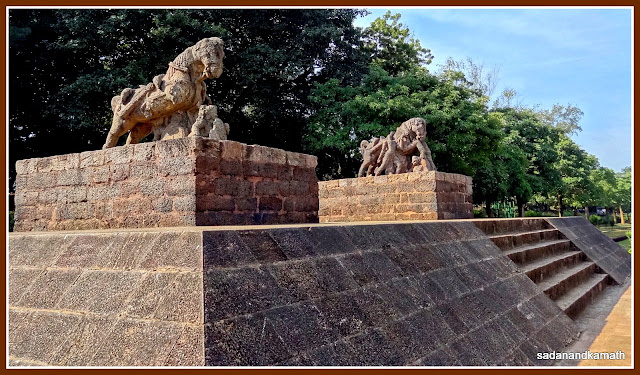In continuation from the trip to Dhauligir, Udaygiri, Khandagiri and Nandankanan.
After
lunch at Dalma Restaurant in Bhubaneshwar, we resumed our journey for Konark
around 2.00 p.m. The distance between Bhubaneshwar and Konark is 65 kms. After
some initial slow movement of traffic in the outskirt of Bhubaneshwar where the
road widening work was going on to make Konark/Puri a four-lane road, the
journey was smooth. We took a break at Pipli, a small town famous for its appliqué
works. There are shops selling appliqué works on both the side of the road
making it a very colourful shopping centre. It is also a road junction for bifurcation to Konark and Puri.
A Short Break at Pipli
– The Applique Centre of Odisha
The
important feature of Pipli town is that each and every family has been associated with applique works for centuries. We entered one of the numerous shops in Pipli
selling applique items. Our idea was to know from him the origin of applique crafts
in Pipli and its surrounding areas.
According to the shopkeeper, the applique craft was as old as Jagannath
temple Puri as the applique craft is closely associated with Jagannath temple
and the rath yatras (car festivals). I have noticed from the pictures of
Jagannath Rath Yatras that all the raths are covered with sheets (more like canopies) in combination with red and
yellow/black/blue cloth over which a lot of applique works have been
done. Over a period of time, the applique works were fancied by the local as well as tourists visiting Puri and Konark. The
traditional crafts that were associated with rath yatras were wall hangings, canopies
and umbrellas. Now, the craft has branched out into making pillow
covers, lampshades, ladies bags, small purses or even frocks for small girls.
The
display of applique works in the row of shops would give an impression from a
distance that some paintings on the main fabric are involved. But in reality,
it is only the patch works of fabrics depicting gods, animals,
flowers etc stitched on the main fabric supplemented by some mirror works. The miniature
designs and borders are done by sewing threads of various colours. Generally, bright and contrasting colours of fabrics are used on the base fabric.
It is obvious that the applique works depicting three gods of Jagannath Temple - Jagannath, Balbadra and Subhadra are in great demand. At the
end of our discussion with the shopkeeper, we bought a couple of wall hangings,
lampshades and small bags as souvenirs from Pipli.
 |
| Applique work on a wall hanging on display at Pipli on way to Konark-Puri |
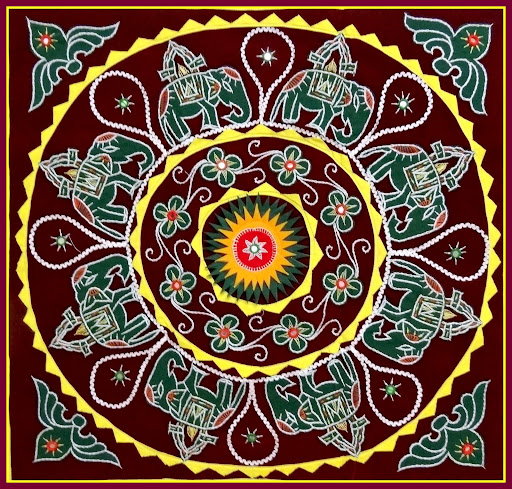 |
| Applique works on a wall hanging with elephants and flowers |
 |
| Applique work on a star shaped lampshade |
 |
| Ladies bag with applique works |
 |
OTDC's Yatri Niwas in Konark. Kanark Sun temple is less than 1 km from here.
Evening and Night Views
of Konark Sun Temple
Konark
Sun Temple is an UNESCO heritage site. Most of the tourists visit Puri and
cover Konark Sun Temple either as a day trip while returning to Bhubaneshwar or Puri. We,
however, decided to stay overnight in Konark in order to have an evening and
night as well as morning views of the Sun temple. We stayed in OTDC’s Yatri
Niwas which, in my view, is the best staying option in Konark. We
checked-in at the Yatri Niwas around 4.00 p.m. After some rest and
freshening, we walked towards the Sun Temple which is less than one km from
Yatri Niwas.
Sun
Temple has been built over a model of a huge chariot having intricately carved 24
wheels, drawn by seven horses carrying the Sun god. Each horse is supposed to
denote the day of a week and each wheel the hours of the day. It was
constructed some time during 12th-13th century in a
east-west axis of Sun so that the first rays of the Sun falls on the temple
upon sunrise over Bay of Bengal. Sun temple and Nata Mandir (dancing hall) in
front of it are made of sand stones.
Since the temple is very close to the sea shores (Bay of Bengal), over a
passage of time, the main sanctum sanctorum has crumbled. The roof of the Nata
Mandap (dancing hall) in front of the main temple has collapsed. What remains
now is only the pillars and the raised platform. The Bhog Mandap (kitchen and dinning hall)
on the southern side of the complex has vanished except the base. Many sculptures and carvings have been eroded
after facing vagaries of climate over the years. However, the Jagamohana
(audience hall) adjunct to the sanctum sanctorum is almost intact with exquisite
carvings. Still, whatever has remained
of temple and sculptures are still awesome and worth viewing before these also fall victims to the sea wind and climate.
The
broken walls of the collapsed structure of the Sun temple have three huge black stone sculptures of Sun god on the south, west and north sides
each representing the morning, mid-day and setting sun respectively. The erotic
sculptures are on the walls of the temple and Jagmohana but I could not locate
a single erotic sculpture on the walls and pillars of Nata Mandap (dancing
hall).
There
was a moderate crowd in the temple complex probably like us to view Sun temple architecture in the setting sun
and also under floodlights in the night. While we took a round of south-western
part of the temple to see the sculptures and carvings under the setting sun,
regarding the eastern face, the light was not sufficient to take pictures
unless one uses flash. Of course, I
could take some close-up pictures even under the poor light condition. After
the sunset, floodlights focusing the Sun temple and Nata Mandap (dance hall) were switched
on. However, to get the real impact of the floodlights on the monuments, we had
to wait for some more time until it was pitched dark when the monuments sparkle
in golden colour.
Some
pictures of Konark Sun Temple taken in the evening and night are uploaded below
:
|
 |
| Sun temple, Konark seen from the gate in the evening. |
 |
| Sun Temple Konark - Evening shot -
Relief carvings on the southern wall of Nata Mandir. |
 |
| One of 24 wheels at the southern side
base of Sun Temple with relief carvings |
 |
| A
close up of an evening shot of relief carvings on the southern side of Sun temple base. |
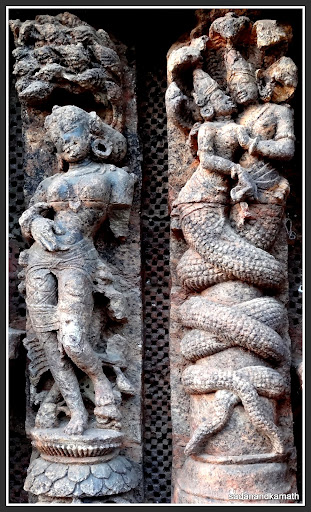 |
| Sun Temple Konark - Evening shot - Close
ups of relief carvings on the southern side of the base of the temple. On the
right are an amorous couple in naag-naagin form |
 |
| Sun Temple Konark - A part of the Nata
Mandir in the night under floodlight. |
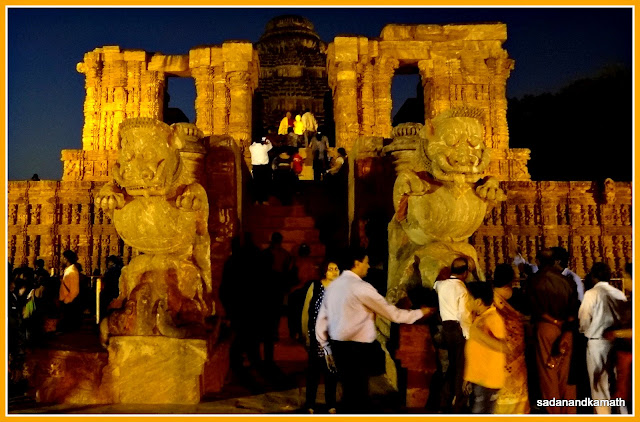 |
| Entrance to Sun temple through Nata
Mandir under floodlight in the night. |
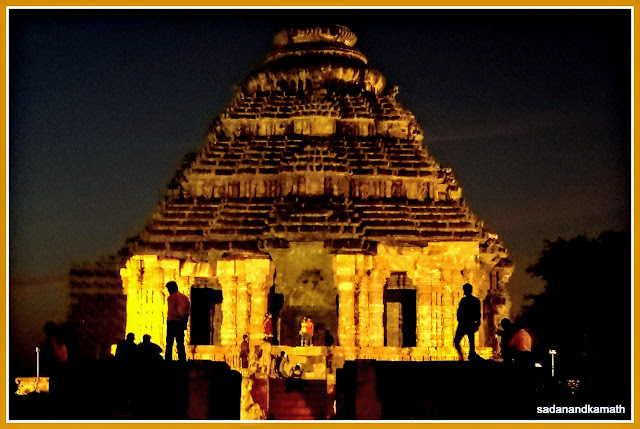 |
Sun Temple in the night under floodlight
Morning View of Konark
Sun Temple
We
had thought of visiting Chandrabhaga beach, 3 kms from Konark for watching
sunrise but in the previous night, we decided to skip it as this would have
entail some loss of time for our morning visits to Konark Sun Temple. So we got
up early, completed our breakfast and reached Konark Sun Temple by 9.00 a.m. mainly
to photograph south-eastern side of the temple when the sun rays fall on them in
the morning. We spent about two hours in the temple complex viewing the
sculptures and carvings in details which was not possible in the previous evening
due to low light and thereafter the floodlights. It may be noted that the
intricate nature of the carvings get lost under floodlights. By 11.00 a.m., the sun
became too strong for photography as well as for us. So we returned to the
comfort of Yatri Niwas.
Some
pictures of the morning view of the Sun Temple complex are uploaded below:
 |
Morning view of Sun temple, Konark from the gate
 |
Sun Temple Konark - Morning shot -
Entrance to the Nata Mandir of the temple
 |
Sun Temple Konark - Morning shot - The
remains of Nata Mandir (dancing hall) with heavily carved base and huge
pillars.
The southern side of the high rise platform of Konark
Sun temple. On the top of the base is the majorly ruined back side of the main Sun temple.
 |
| Sculpture of wo of seven horses of the Sun Temple chariot |
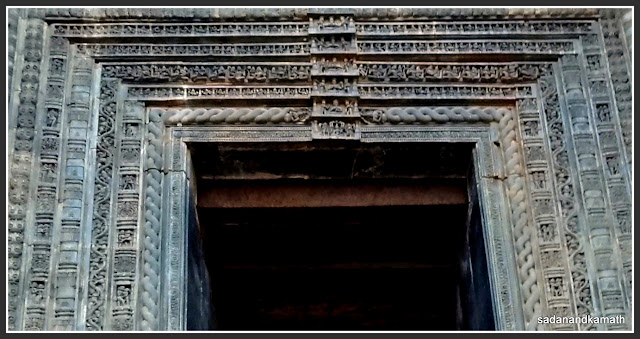 |
| Exquisite carvings on the granite stone
eastern door frome of Jagamohana (audience hall) of Sun Temple |
 |
| Carvings on the bottom part of the granite door frame of the Jagamohana (audience hall) of Sun Temple |
Sculptures of two war horses adore on a
raised platform on the southern side of the courtyard facing Sun temple
A pair of monolithic elephants on the
northern side of the courtyard of Sun Temple
 |
| Idol with damaged hands facing the
northern side from the sun temple. |
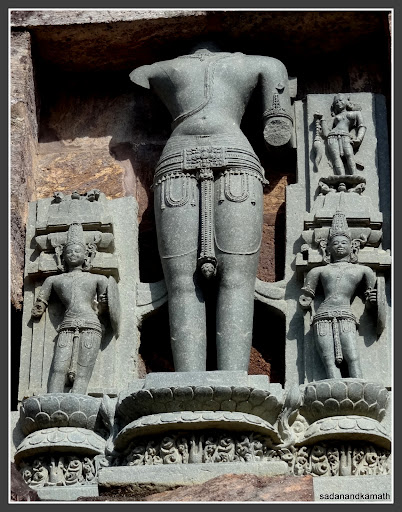 |
| The broken idol of Sun god deity facing the south side |
 |
| Idol of Sun God with broken hands facing western side of the wall of Sun Temple |
 |
The intricate carvings on the pedestal
of the entrance of now ruined Chhayadevi temple in Konark temple complex
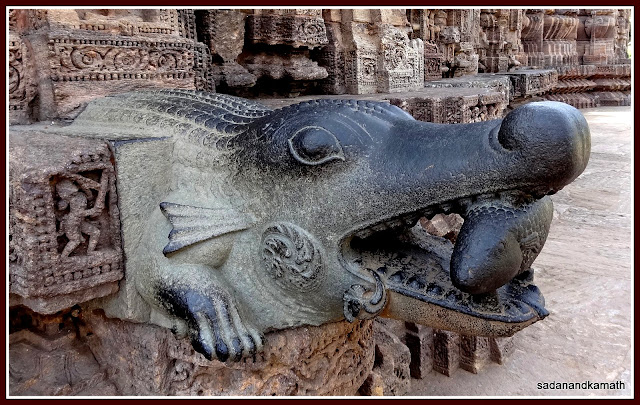 |
Outlet for sacred oblations in the form
of a crocodile holding a fish, attached to Chhayadevi Temple inside Konark temple
complex.
To Puri
After
a quick lunch in the restaurant of Yatri Niwas, we departed for Puri around
1.00 p.m. by hiring a Maxima van @ Rs.700/- for Puri drop. The distance between
Konark and Puri is 30 kms through the marine drive (coastal drive). After about 3 kms from Konark, we stopped at
Chandrabhaga beach for some time. The beach was clean and there was not much of
a crowd. At some distance, I could see rows of fishing boats parked on the
beach. Probably, the beach is used by fishermen as base for their fishing
activities.
After
spending about 30 minutes on the beach, we resumed our journey to Puri. From
here, the entire journey is all along the coast. The road is excellent with
dense trees lined up on both sides of the road. I could see displays of some authorised picnic spots all along the costal side. We reached Puri by 2.30 p.m.
and checked in OTDC’s Pantniwas located at the Puri beach. Because of its
location and the value for money, Pantniwas gets booked well in advance
especially during Rath Yatra and November-February peak season.
After
some rest, we strolled on the beach
until dark. Even in the night, there was some crowd as the beach is well
lighted. Contrary to my expectation, the
beach was clean and sea was calm.
 |
| Chandrabhagha beach |
 |
| A fisherman in his boat is about to spread his fishing net in sea off Chandrabhaga beach |
 |
| Konark-Puri Marine Drive |
 |
| A beach island between Sea and back water somewhere off Konark-Puri Marine Drive |
 |
View of Puri beach from Pantniwas room |
Puri beach after sunset
Visit to Jagannath
Temple and Puri Beach
Today
was the important day of our stay in Puri as we were slated to visit Jagannath
temple of the east, one of the four dhams of India located in the four directions
– the other three being Badrinath in the north, Dwarka in the west, Rameshwaram in the south. While
we had already visited, Badrinath, Dwarka and Rameshwaram many years back,
visit to Jagannath temple eluded us despite planning to visit Bhubaneshwar
many times. Visit to Jagannath temple was always a tricky issuefor me because of a
large pilgrim crowd that throng the temple almost throughout the year. I had
also heard about the harassment of pilgrims by pandas of the temple. Somehow,
I do not like to visit any place including the temples where there is a
congregation of large crowd. But having visited Puri and not visiting Jagannath Temple can be an awkward situation for me. To make sure that we over come all sort of problems both real and imaginary, I had kept one full day exclusively for
Jagannath temple.
In
the previous day, I had apprised the Manager of Pantniwas, Puri of our
intention to visit Jagannath temple the next day and was taking his guidance in
having a smooth darshan at the temple. He said that one senior panda of the
temple often visit Pantniwas to take the visitors to Jagannath temple in the
morning. In case he comes, he would call me to talk to him. As expected, Panda
came to Pantniwas in the evening and I met him. His plan was that he would buy
the special tickets for darshan which opens just before the timing for special darshan
starts and send an auto rickshaw at 7.30 a.m.to pick up from Pantniwas. I
agreed to his proposal. But having negative impression of pandas of Jagannath
temple, I was apprehensive about fleecing me for arranging the
darshan under the guise of special darshan tickets. As I later understood from the
Manager also from other employees of Pantniwas, our Panda would take
dakshina (offerings) of whatever the amount we pay without any
reservation on his part.
We
got up early in the morning and completed our morning chores to be ready before the
7.30 a.m. As promised, two auto rickshaws came to the hotel at the appointed
time to take four of us to Jagannath temple which was at the distance of about
2 kms from Pantniwas. At the temple’s main gate, our Panda was waiting for us with tickets to take inside the temple. After security check at the gate, we entered the temple complex which looked quite bigger than what one could imagine seeing it from outside. There was a big queue for darshan inside
the temple complex. But according to our Panda, the queue was not as long as
normally seen on most of the days. He virtually dragged us through the pilgrim
crowd to the queue for special ticket darshan. I found that there were about 50
persons ahead of us. After about 5
minutes, we were ushered inside the cave like round sanctum sanctorum of the
temple. There were many deities inside the sanctorum with the deities of
Jagannath, Balbhadra and Subhadra occupying the middle part. There were as many
pandas inside the sanctorum as he deities, each competing with others to take the visitors to
their folds. Our Panda had cautioned us not to keep much cash in hand to place
at the feet of deities as some of the pandas have been known to snatch all the
cash in hand of pilgrims to place at the feet of the deities knowing very well
that no pilgrim would take a part of cash back once kept at the feet of the
deities. I noticed that one of the
Pandas actually did the same thing as told to us by our Panda.
Despite
relatively less crowd, the atmosphere in the sanctorum was a bit chaotic more
because of pandas than the pilgrims. Nevertheless, it was a smooth darshan for
us contrary to our expectation. We were inside the sanctorum for about 10
minutes and completed the parikrama (round) of the sanctorum which itself
was a luxury as in normal days, the security staff would just push the pilgrims
out immediately after darshan to avoid overcrowding inside the sanctorum. We could
not believe that our darshan of Lord Jagannath was over in less than one hour from the start from Pantniwas and by 8.30 a.m., we were out completing a round of other subsidiary temples
inside the complex. Photography inside the temple is strictly prohibited.
It
was such a great relief for us when our visit to Jagannath temple ended with a
smooth darshan without any fleecing by temple pandas. Our Panda did not take
any money from us by saying that he would visit us in the evening. We return to
Pantniwas by 9.00 a.m. We took breakfast in Pantniwas’s restaurant which was
included in the room tariff. After some rest, we hired two auto rickshaws to
market around Jagannath temple for some window shopping. In the event, we
bought a couple of Odiya sarees and bed sheets having the typical Odisha handicraft. We were
back to Pantniwas by 12 noon. During our absence, our Panda had arrange to send
us a packet full of exotic Odiya sweets Malpuri with Rabdi which were very tasty.
Post lunch, we rested in the afternoon. After evening tea and some snacks, we
proceeded to Puri beach, this time actually to play in the sea water. The sky
was clear and the chance of watching a great sunset over Bay of Bengal was cent
percent. After sunset, we were to visit a sand artist’s place on the beach
itself. However, the place was closed from all the four sides as the sand
artists were still working on a theme befitting the Christmas. All I could see
from outside after standing on a makeshift platform was a sculpture of a Chirstian saint and Santa
Clause made up of sands.
As we returned to Pantniwas, our Panda came to our room bringing with him the prasad (Lord Jagannath's offereings) for all of us. He gave discourses on some important temples in Bhubaneshwar and Puri in general and about Jagannath Puri temple in particular. After the completion of his discourses, I happily paid Rs.1001/- to him as dakshina (offering) on behalf of our two families.
 |
Glimpses of Jagannath temple seen from a narrow lane. |
Jagannath temple seen from the road
side. It is said that the Arun Kambha (the pillar on the left) belonged to Sun
Temple Konark but it was removed and installed here during the Maratha
rule.
 |
A long shot of Puri beach |
Sun about to set in over Bay of Bengal off Puri beach
Sand sculpture of a Christian saint on Puri beach on the eve of X'mas.
Puri beach in the night
With this, our visit to Puri was almost complete, looking forward to a day visit to Chilika Lake on the next day.
